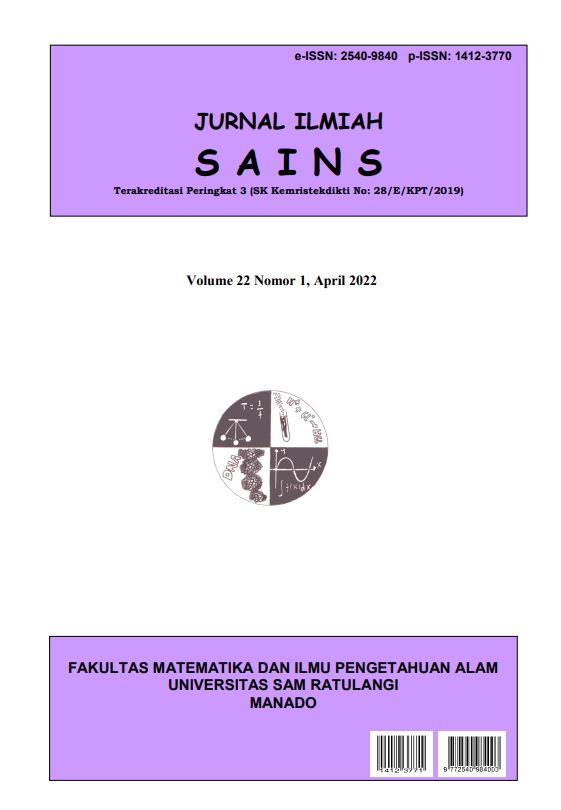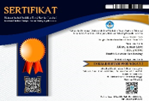Variasi Konsentrasi Asam Borat pada Reaksi Amidasi Asam Sinamat dan Potensinya Sebagai Antikolesterol
DOI:
https://doi.org/10.35799/jis.v22i1.37492Abstract
Tujuan penelitian ini yaitu untuk mengetahui reaksi amidasi asam sinamat dengan N, N-dietil amina menggunakan katalisator asam borat dan mengetahui aktivitas antikolesterol dari produk senyawa hasil amidasi. Reaksi amidasi asam sinamat dengan N, N-dietil amina menggunakan variasi konsentrasi (% mol) asam borat sebagai katalis yaitu 5, 10, 15, 20 dan 25%. Hasil reaksi amidasi dikarakteristik menggunakan FT-IR, 1H-NMR dan 13C-NMR. Aktivitas antikolesterol dianalisis menggunakan metode Liebermann-Burchard. Hasil penelitian menunjukkan bahwa produk amidasi asam sinamat yaitu 20,47%, 22,99%; 23,37%; 26,77% dan 30,28% untuk variasi mol asam borat secara berturut-turut 5%, 10, 15, 20 dan 25%. Hasil karakterisasi dengan FT-IR, 1H-NMR dan 13C-NMR menunjukkan bahwa produk hasil amidasi berupa senyawa N, N-dietil sinamamida. Senyawa hasil amidasi mampu menurunkan kadar kolesterol sebesar 5,24%; 27,18% dan 13,22% dengan konsentrasi senyawa berturut-turut sebesar 50, 100, dan 150 ppm. Semakin besar persen mol katalisator asam borat yang digunakan, semakin besar senyawa hasil amidasi yang diperoleh. Produk hasil amidasi yang diperoleh yaitu senyawa N, N-dietil sinamamida yang berpotensi sebagai antikolesterol dengan aktivitas optimum pada konsentrasi 100 ppm.Â
Kata kunci: Amidasi; antikolesterol; asam borat; asam sinamat; sinamamida
 Mole Variation of Concentration Boric Acid in The Amidation Reaction  of Cinnamic Acid and Its Potential as Anticholesterol
 ABSTRACT
The aims of this study to determine the amidation reaction of cinnamic acid with N, N-diethylamine using a boric acid catalyst and to determine the anticholesterol activity of the amidation product. The amidation reaction of cinnamic acid with N, N-diethyl amine using various concentration (% mole) of boric acid as a catalyst, namely 5, 10, 15, 20, and 25%. The amidation reaction results were characterized using FT-IR, 1H-NMR, and 13C-NMR. The anticholesterol activity was analyzed using the Liebermann-Burchard method. The results showed that the amidation products of cinnamic acid were 20.47%, 22.99%; 23.37%; 26.77%, and 30.28% for variations in moles of boric acid 5%, 10, 15, 20, and 25%, respectively. The results of characterization using FT-IR, 1H-NMR and 13C-NMR showed that the amidation product was N, N-diethyl cinnamamide. The compound resulting from the amidation was able to reduce cholesterol levels by 5.24%; 27.18%, and 13.22% with compound concentrations of 50, 100, and 150 ppm, respectively. The greater the mole percent of boric acid catalyst used, the greater the amidation product obtained. The amidation product formed is N, N-diethyl cinnamamide which has the potential as an anticholesterol with optimum activity at a concentration of 100 ppm.
Keywords: Amidation; anticholesterol; boric acid; cinnamic acid; cinnamamide
References
Adu, J.K., Amengor, C.D.K., Kabiri, N., Orman, E., Abla, S., Patamia, G. & Okrah, B.K. 2019. Validation of a Simple and Robust Liebermann – Burchard Colorimetric Method for the Assay of Cholesterol in Selected Milk Products in Ghana. International Journal of Food Science, 2019: 1–7.
Aghayan, M.M., Tavana, M.M. & Rabah, B. 2016. Sulfonated reduced graphene oxide as a highly efficient catalyst for direct amidation of carboxylic acids with amines using ultrasonic irradiation. Ultrasonics Sonochemistry, 29: 371–379. https://doi.org/10.1016/j.ultsonch. 2015.10.009.
Borul, S.B. & Agarkar, S.V. 2014. Synthesis and Characterization of Novel Cinnamamide Deriverties and Their Antimicrobial Activities. IOSR Journal of Applied Chemistry, 7(12): 52–55. https://doi.org/10.9790/5736-071215255.
Charville, H. 2012. Direct Amide Formation Between Carboxylic Acids and Amines: Mechanism and Development of Novel Catalytic Solutions. Durham University.
Coates, J. 2006. Encyclopedia of Analytical Chemistry -Interpretation of Infrared Spectra, A Practical Approach. In R. A. Meyers (Ed.), Encyclopedia of Analytical Chemistry. John Wiley & Sons, New York.
Harichandran, G., Amalraj, S.D. & Shanmugam, P. 2011. Boric acid Catalyzed Efficient Synthesis of Symmetrical N,N’-Alkylidene Bisamides. Journal of the Iranian Chemical Society, 8(1): 298–305.
Hasan, M.K.N., Kamarazaman, I.S., Arapoc, D.J., Taza, N.Z.M., Amom, Z.H., Ali, R.M., Arshad, M.S.M., Shah, Z.M. & Kadir, K.K.A. 2015. Anticholesterol activity of anacardium occidentale linn. does it involve in reverse cholesterol transport. Sains Malaysiana, 44(10): 1501–1510. https://doi.org/10.17576/ jsm-2015-4410-16.
Huy, P., & Zoller, B. 2019. Boron Lewis Acid Catalysis: How to Synthesize Amides Atom-Efficiently. Nachrichten Aus Der Chemie (Journal of the German Chemical Society GDCh), 67(5): 51–54. https://doi.org/10.1002/ nadc.20194087418.
Lanigan, R.M., Starkov, P. & Sheppard, T.D. 2013. Direct synthesis of amides from carboxylic acids and amines using B(OCH2CF3)3. Journal of Organic Chemistry, 78(9): 4512–4523. https://doi.org/10.1021/jo400509n.
Leggio, A., Bagalà , J., Belsito, E.L., Comandè, A., Greco, M. & Liguori, A. 2017. Formation of amides: One-pot condensation of carboxylic acids and amines mediated by TiCl4. Chemistry Central Journal, 11(1): 1–12. https://doi.org/10.1186/s13065-017-0318-9.
Li, L., Dutkiewicz, E.P., Huang, Y., Zhou, H. & Hsu, C. 2018. ScienceDirect Analytical methods for cholesterol quantification. Journal of Food and Drug Analysis, 27(2): 375–386. https://doi.org/10.1016/j.jfda.2018.09.001.
Pathan, R.U. & Agarkar, S.V. 2014. SiO2 Supported Synthesis of N,N Disubstituted Cinnamamides. Research Journal of Chemical Sciences, 4(5): 56–58.
Peperidou, A., Pontiki, E., Hdjipavlou-Litina, D., Voulgari, E. & Avgoustakis, K. 2017. Multifunctional cinnamic acid derivatives. Molecules, 22(8): 1–17. https://doi.org/10.3390/molecules22081247.
Pokhrel, N., Vabbina, P.K. & Pala, N. 2016. Sonochemistry: Science and Engineering. Ultrasonics Sonochemistry, 29: 104–128. https://doi.org/10.1016/j.ultsonch.2015.07.023.
Reshma, B.G., Nadar, M.S.A.M. & Selvakumar, P.M. 2018. A Review on Anti-Cholesterol Drugs and their Mechanisms. Journal of Medicinal Chemistry and Drug Design, 1(1): 1–6.
Saritha, K., Rajitha, G., Sudheerkumar, K. & Umamaheswari, A. 2018. Synthesis , Molecular Docking Studies And Antimicrobial Activity Of Substituted Cinnamides. International Journal of Pharmacy and Biological Sciences, 8(3): 770–778.
Shahrisa, A., Esmati, S. & Nazari, M.G. 2012. Boric acid as a mild and efficient catalyst for one-pot synthesis of 1-amidoalkyl-2-naphthols under solvent-free conditions. Journal of Chemical Sciences, 124(4): 927–931. https://doi.org/10.1007/s12039-012-0285-6.
Sharma, N., Bhagat, N. & Bhagat, S. 2017. Ultrasound-Accelerated Amide Coupling Reactions Directed toward the Synthesis of 1-Acetyl-3-carboxamide- β -carboline Derivatives of Biological Ultrasound-Accelerated Amide Coupling Reactions Directed toward the Synthesis of 1-Acetyl-3-carboxamide- β -car. Syn Open, 1: 8–10. https://doi.org/ 10.1055/s-0036-1588167.
Sharma, P. 2011. Cinnamic acid derivatives: A new chapter of various pharmacological activities. J. Chem. Pharm. Res., 3(2): 403–423.
Tang, P. 2012. Discussion Addendum for: Boric Acid Catalyzed Amide Formation From Carboxylic Acids And Amines: N-Benzyl-4-Phenylbutyramide. Organic Syntheses, 89: 432–437. https://doi.org/ 10.15227/orgsyn.089.0432.
World Health Statistic. 2019. Monitoring Health for the SDGs. In World Health Statistic (Issue March). https://doi.org /10.1007/978-1-349-04787-1_12.







